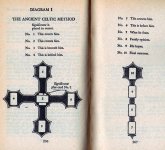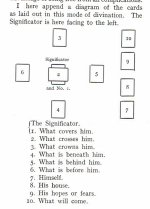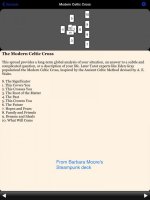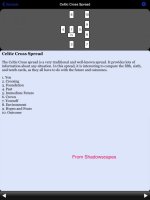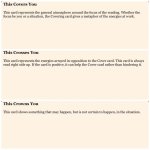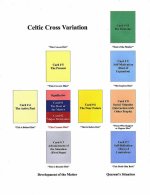Barleywine
At tarotbear's suggestion, I'm starting this thread to try to get a handle on how many different "flavors" of the Celtic Cross spread are in general use today. We all think we know what it's supposed to be, but there doesn't seem to be much agreement on what to name and number many of the positions in the "cross" section, and some in the "staff." When I started in the last half of the 20th century, the two main versions were A.E. Waite's from the Pictorial Key to the Tarot (1910), and Eden Gray's from her 1960 book The Tarot Revealed. (I've attached pictures of both). Waite's 3-through-6 number sequence started at the top and moved like the Catholic "sign of the Cross," while Gray's flowed more like a wheel, clockwise from the bottom (I liken it to the daily path of the Sun - midnight, dawn, noon and sunset). Recently, while helping interpret CC spreads here, I've seen a wide range of different arrangements, some of which made little sense to me.
Personally, I use a modified version of Gray's layout, as follows:
The "cross" section is about the question; the "staff" section is about the querent.
Position #1 (covering) - The circumstances of the question; why the querent came.
Position #2 (crossing) - Opposing forces in the matter.
Position #3 (beneath) - The Distant Past; not subject to change.
Position #4 (behind; to the left) - The Recent Past, just passing away. Note that, following Gray's model, I've never paid any attention to which way the Significator is facing; lately I haven't even been using a Significator.
Position #5 (above) - Gray said "what may come to pass;" I just say "the realm of possibilities" and call it the Present.
Position #6 (before; to the right) - The Near Future. Again, no Significator orientation is considered; Near Future is always to the right.
(I actually read positions 4, 5 and 6 as a continuum, since they can blend into one another as far as timing goes)
Position #7 (bottom of staff) - Gray said "the querent's fears," but I like the modern assignment of the Self here - especially the deepest part of the Self where all the psychological "baggage" accumulates (so the full range of subconscious and unconscious factors goes here); thus, "pessimism" as a negative emotion does fit here.
Position #8 (second from bottom) - Gray said "family opinion" but others have said "the influence of other people" and "the querent's environment" in general, and I go with that.
Position #9 (third from the bottom) - Gray said "the querent's hopes," but I look at it more as the querent's "stake" in the matter; what he or she has to gain or lose. Conscious aspirations would go here; "optimism" as a positive emotion would also fit here.
Position #10 (top of the staff) - The end of the matter; the final outcome. I use it the same way.
I'm interested in seeing how those of you who use the CC name and number each position, and especially how you handle positions 3 through 6.
Personally, I use a modified version of Gray's layout, as follows:
The "cross" section is about the question; the "staff" section is about the querent.
Position #1 (covering) - The circumstances of the question; why the querent came.
Position #2 (crossing) - Opposing forces in the matter.
Position #3 (beneath) - The Distant Past; not subject to change.
Position #4 (behind; to the left) - The Recent Past, just passing away. Note that, following Gray's model, I've never paid any attention to which way the Significator is facing; lately I haven't even been using a Significator.
Position #5 (above) - Gray said "what may come to pass;" I just say "the realm of possibilities" and call it the Present.
Position #6 (before; to the right) - The Near Future. Again, no Significator orientation is considered; Near Future is always to the right.
(I actually read positions 4, 5 and 6 as a continuum, since they can blend into one another as far as timing goes)
Position #7 (bottom of staff) - Gray said "the querent's fears," but I like the modern assignment of the Self here - especially the deepest part of the Self where all the psychological "baggage" accumulates (so the full range of subconscious and unconscious factors goes here); thus, "pessimism" as a negative emotion does fit here.
Position #8 (second from bottom) - Gray said "family opinion" but others have said "the influence of other people" and "the querent's environment" in general, and I go with that.
Position #9 (third from the bottom) - Gray said "the querent's hopes," but I look at it more as the querent's "stake" in the matter; what he or she has to gain or lose. Conscious aspirations would go here; "optimism" as a positive emotion would also fit here.
Position #10 (top of the staff) - The end of the matter; the final outcome. I use it the same way.
I'm interested in seeing how those of you who use the CC name and number each position, and especially how you handle positions 3 through 6.

